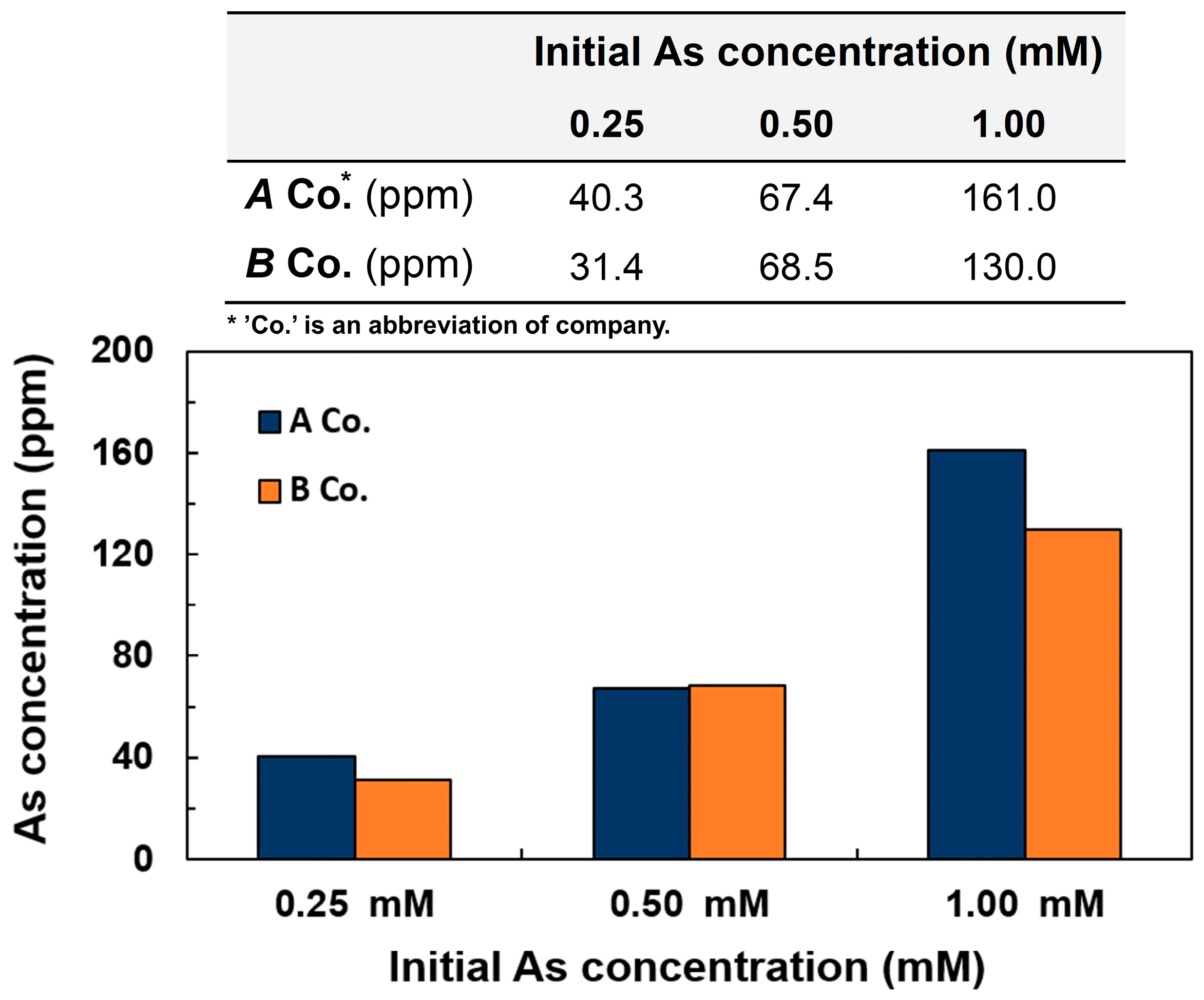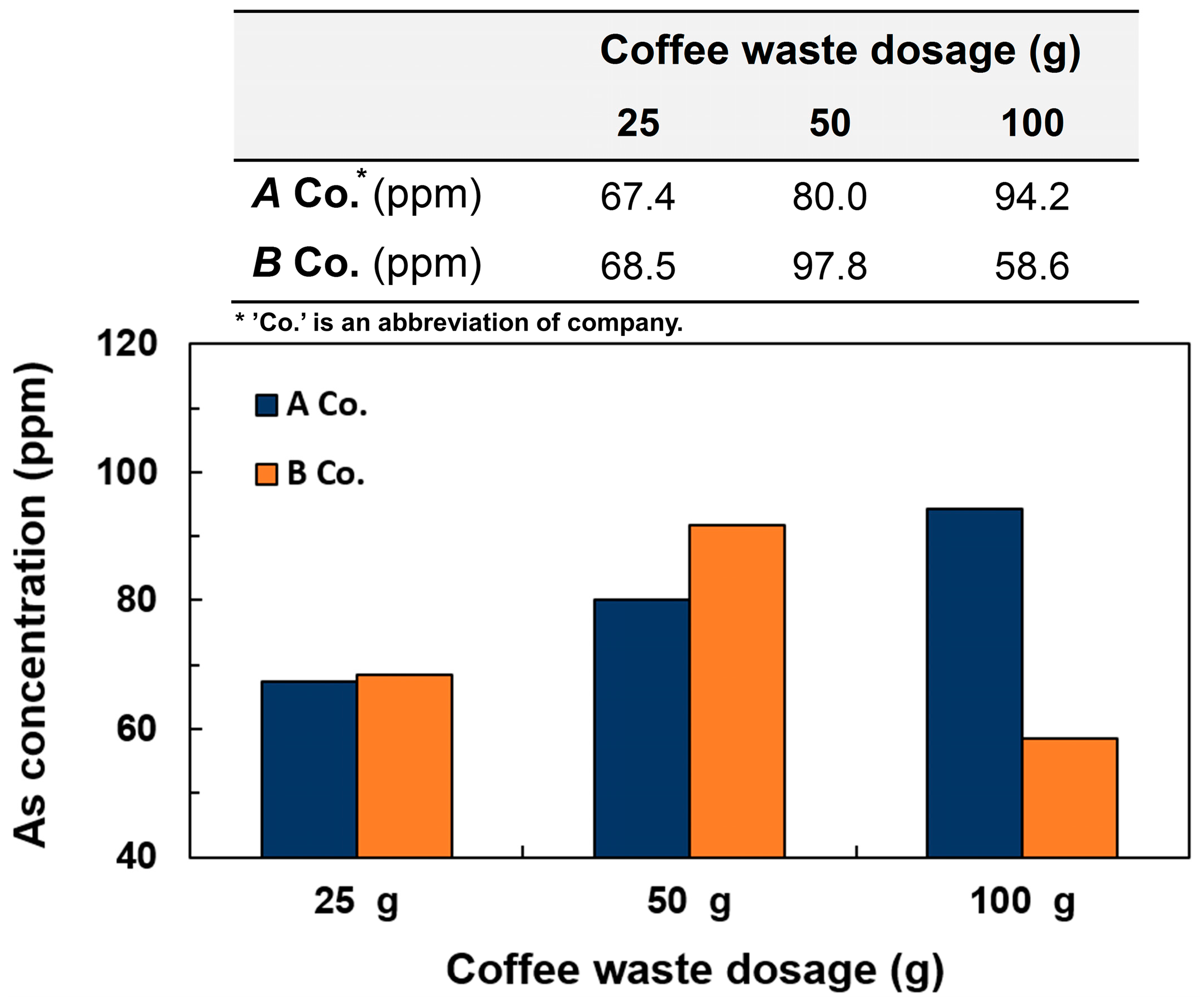An Environmentally Benign Approach for As (V) Absorption from Wastewater Using Untreated Coffee Grounds—Preliminary Results
Abstract
:1. Introduction
2. Materials and Methods
2.1. Sample Preparation and Adsorption Experiment
2.2. Characterization
3. Results and Discussion
3.1. Structural Characteristics
3.2. Absorption Properties
4. Conclusions
Acknowledgments
Author Contributions
Conflicts of Interest
References
- Smith, V.H. Eutrophication of freshwater and coastal marine ecosystems—A global problem. Environ. Sci. Pollut. Res. 2003, 10, 126–139. [Google Scholar] [CrossRef]
- Gleick, P.H. Global freshwater resources: Soft-path solutions for the 21st century. Science 2003, 302, 1524–1528. [Google Scholar] [CrossRef] [PubMed]
- Flaten, T.P. Aluminium as a risk factor in Alzheimer’s disease, with emphasis on drinking water. Brain Res. Bull. 2001, 55, 187–196. [Google Scholar] [CrossRef]
- Arnell, N.W. Climate change and global water resources. Glob. Environ. Chang.-Hum. Policy Dimens. 1999, 9, S31–S49. [Google Scholar] [CrossRef]
- Carriger, J.F.; Castro, J.; Rand, G.M. Screening historical water quality monitoring data for chemicals of potential ecological concern: Hazard assessment for selected inflow and outflow monitoring stations at the water conservation areas, South Florida. Water Air Soil Pollut. 2016, 227. [Google Scholar] [CrossRef]
- Shakoor, M.B.; Nawaz, R.; Hussain, F.; Raza, M.; Ali, S.; Rizwan, M.; Oh, S.-E.; Ahmad, S. Human health implications, risk assessment and remediation of As-contaminated water: A critical review. Sci. Total Environ. 2017, 601–602, 756–769. [Google Scholar] [CrossRef] [PubMed]
- Bosch, A.C.; O’Neill, B.; Sigge, G.O.; Kerwath, S.E.; Hoffman, L.C. Heavy metals in marine fish meat and consumer health: A review. J. Sci. Food Agric. 2016, 96, 32–48. [Google Scholar] [CrossRef] [PubMed]
- Keil, D.E.; Berger-Ritchie, J.; McMillin, G.A. Testing for toxic elements: A focus on Arsenic, Cadmium, Lead, and Mercury. Lab. Med. 2011, 42, 735–742. [Google Scholar] [CrossRef]
- Balakrishnan, H.; Velu, R. Eco-Friendly technologies for heavy metal remediation: Pragmatic approaches. In Environmental Sustainability: Role of Green Technologies; Springer: New Delhi, India, 2015; Volume 1, pp. 205–215. [Google Scholar]
- Henke, K.R. Arsenic in natural environments. In Arsenic: Environmental Chemistry, Health Threats, and Waste Treatment; Henke, K.R., Ed.; John Wiley & Sons: Hoboken, NJ, USA, 2009; pp. 69–236. [Google Scholar]
- Garelick, H.; Jones, H.; Dybowska, A. Arsenic pollution sources. In Reviews of Environmental Contamination and Toxicology; Garelick, H., Jones, H., Eds.; Springer: New York, NY, USA, 2008; Volume 197, pp. 17–60. [Google Scholar]
- Islam, M.S.; Ahmed, M.K.; Raknuzzaman, M.; Habibullah-Al-Mamun, M.; Islam, M.K. Heavy metal pollution in surface water and sediment: A preliminary assessment of an urban river in a developing country. Ecol. Indic. 2015, 48, 282–291. [Google Scholar] [CrossRef]
- Carolin, C.F.; Kumar, P.S.; Saravanan, A.; Joshiba, G.J.; Naushad, M. Efficient techniques for the removal of toxic heavy metals from aquatic environment: A review. J. Environ. Chem. Eng. 2017, 5, 2787–2799. [Google Scholar] [CrossRef]
- Hao, L.; Desai, M.K.; Wang, P.; Valiyaveettil, S. Successive extraction of As(V), Cu(II), and P(V) ions from water using surface modified ghee residue protein. ACS Sustain. Chem. Eng. 2017, 5, 3742–3750. [Google Scholar] [CrossRef]
- Boonamnuayvitaya, V.; Chaiya, C.Y.; Tanthapanichakoon, W.; Jarudilokkul, S. Removal of heavy metals by adsorbent prepared from pyrolyzed coffee residues and clay. Sep. Purif. Technol. 2004, 35, 11–22. [Google Scholar] [CrossRef]
- Babel, S.; Kurniawan, T.A. Low-cost adsorbents for heavy metals uptake from contaminated water: A review. J. Hazard Mater. 2003, B97, 219–243. [Google Scholar] [CrossRef]
- Peng, Q.M.; Guo, J.X.; Zhang, Q.R.; Xiang, J.Y.; Liu, B.Z.; Zhou, A.G.; Liu, R.P.; Tian, Y.J. Unique lead adsorption behavior of activated hydroxyl group in two-dimensional titanium carbide. J. Am. Chem. Soc. 2014, 136, 4113–4116. [Google Scholar] [CrossRef] [PubMed]
- Upadhyay, R.K.; Soin, N.; Roy, S.S. Role of graphene/metal oxide composites as photocatalysts, adsorbents and disinfectants in water treatment: A review. RSC Adv. 2014, 4, 3823–3851. [Google Scholar] [CrossRef]
- Naushad, M.; Mittal, A.; Rathore, M.; Gupta, V. Ion-exchange kinetic studies for Cd(II), Co(II), Cu(II), and Pb(II) metal ions over a composite cation exchanger. Desalin. Water Treat. 2015, 54, 2883–2890. [Google Scholar] [CrossRef]
- Bolisetty, S.; Mezzenga, R. Amyloid–carbon hybrid membranes for universal water purification. Nat. Nanotechnol. 2016, 11, 365–371. [Google Scholar] [CrossRef] [PubMed]
- He, J.; Chen, J.P. A comprehensive review on biosorption of heavy metals by algal biomass: Materials, performances, chemistry, and modeling simulation tools. Bioresour. Technol. 2014, 160, 67–78. [Google Scholar] [CrossRef] [PubMed]
- Boudrahem, F.; Soualah, A.; Aissani-Benissad, F. Pb(II) and Cd(II) removal from aqueous solutions using activated carbon developed from coffee residue activated with phosphoric acid and zinc chloride. J. Chem. Eng. Data 2011, 56, 1946–1955. [Google Scholar] [CrossRef]
- Wu, C.H.; Kuo, C.Y.; Guan, S.S. Adsorption of heavy metals from aqueous solutions by waste coffee residues: Kinetics, equilibrium, and thermodynamics. Desalin. Water Treat. 2016, 57, 5056–5064. [Google Scholar] [CrossRef]
- Kumar, K.S.; Dahms, H.U.; Won, E.J.; Lee, J.S.; Shin, K.H. Microalgae—A promising tool for heavy metal remediation. Ecotoxicol. Environ. Saf. 2015, 113, 329–352. [Google Scholar] [CrossRef] [PubMed]
- Wang, J.; Chen, C. Biosorbents for heavy metals removal and their future. Biotechnol. Adv. 2009, 27, 195–226. [Google Scholar] [CrossRef] [PubMed]
- Nuruddin, M.; Hosur, M.; Uddin, M.J.; Baah, D.; Jeelani, S. A novel approach for extracting cellulose nanofibers from lignocellulosic biomass by ball milling combined with chemical treatment. J. Appl. Polym. Sci. 2016, 133, 42990. [Google Scholar] [CrossRef]
- Wang, L.Y.; Wang, M.J. Removal of Heavy Metal Ions by Poly (vinyl alcohol) and Carboxymethyl Cellulose Composite Hydrogels Prepared by a Freeze–Thaw Method. ACS Sustain. Chem. Eng. 2016, 4, 2830–2837. [Google Scholar] [CrossRef]
- Vardon, D.R.; Moser, B.R.; Zheng, W.; Witkin, K.; Evangelista, R.L.; Strathmann, T.J.; Rajagopalan, K.; Sharma, B.K. Complete utilization of spent coffee grounds to product biodiesel, bio-oil, and biochar. ACS Sustain. Chem. Eng. 2013, 1, 1286–1294. [Google Scholar] [CrossRef]
- Azouaou, N.; Sadaoui, Z.; Djaafri, A.; Mokaddem, H. Adsorption of cadmium from aqueous solution onto untreated coffee grounds: Equilibrium, kinetics and thermodynamics. J. Hazard Mater. 2010, 184, 126–134. [Google Scholar] [CrossRef] [PubMed]
- Chavan, A.A.; Pinto, J.; Liakos, I.; Bayer, I.S.; Lauciello, S.; Athanassiou, A.; Fragouli, D. Spent coffee bioelastomeric composite foams for the removal of Pb2+ and Hg2+ from water. ACS Sustain. Chem. Eng. 2016, 4, 5495–5502. [Google Scholar] [CrossRef]
- Hao, L.; Wang, P.; Valiyaveettil, S. Successive extraction of As(V), Cu(II) and P(V) ions from water using spent coffee powder as renewable bioadsorbents. Sci. Rep. 2017, 7, 42881. [Google Scholar] [CrossRef] [PubMed]
- Marincas, O.; Floare-Avram, V.; Feher, I.; Lazar, D.; Voica, C.; Grosu, I. Inexpensive adsorbents derived from coffee grounds for the treatment of wastewater. Anal. Lett. 2016, 49, 2659–2670. [Google Scholar] [CrossRef]
- Guu, F.; Zhu, G.; Gao, B.; Zhang, D.; Tian, G.; Chen, Y.; Zhang, W.; Qiu, S. Adsorption of vitamin B12 on ordered mesoporous carbons coated with PMMA. Carbon 2005, 43, 2344–2351. [Google Scholar] [CrossRef]
- Ouyang, X.; Ouyang, J.; Guo, F. Development of a fuzzy analytical network process to evaluate alternatives on vitamin B12 adsorption from wastewater. Comput. Chem. Eng. 2016, 95, 123–129. [Google Scholar] [CrossRef]
- AL Othman, Z.A. A review: Fundamental aspects of silicate mesoporous materials. Materials 2012, 5, 2874–2902. [Google Scholar] [CrossRef]
- Wei, Z.; Liang, K.; Wu, Y.; Zou, Y.; Zuo, J.; Arriagada, D.C.; Pan, Z.; Hu, G. The effect of pH on the adsorption of arsenic(III) and arsenic(V) at the TiO2 anatase [101] surface. J. Colloid Interface Sci. 2016, 462, 252–259. [Google Scholar] [CrossRef] [PubMed]





© 2017 by the authors. Licensee MDPI, Basel, Switzerland. This article is an open access article distributed under the terms and conditions of the Creative Commons Attribution (CC BY) license (http://creativecommons.org/licenses/by/4.0/).
Share and Cite
Nam, G.; Kim, M.-S.; Lee, N.; Choi, Y.-H.; Ahn, J.W. An Environmentally Benign Approach for As (V) Absorption from Wastewater Using Untreated Coffee Grounds—Preliminary Results. Water 2017, 9, 867. https://doi.org/10.3390/w9110867
Nam G, Kim M-S, Lee N, Choi Y-H, Ahn JW. An Environmentally Benign Approach for As (V) Absorption from Wastewater Using Untreated Coffee Grounds—Preliminary Results. Water. 2017; 9(11):867. https://doi.org/10.3390/w9110867
Chicago/Turabian StyleNam, Gnu, Min-Suk Kim, Namju Lee, Young-Hoon Choi, and Ji Whan Ahn. 2017. "An Environmentally Benign Approach for As (V) Absorption from Wastewater Using Untreated Coffee Grounds—Preliminary Results" Water 9, no. 11: 867. https://doi.org/10.3390/w9110867





